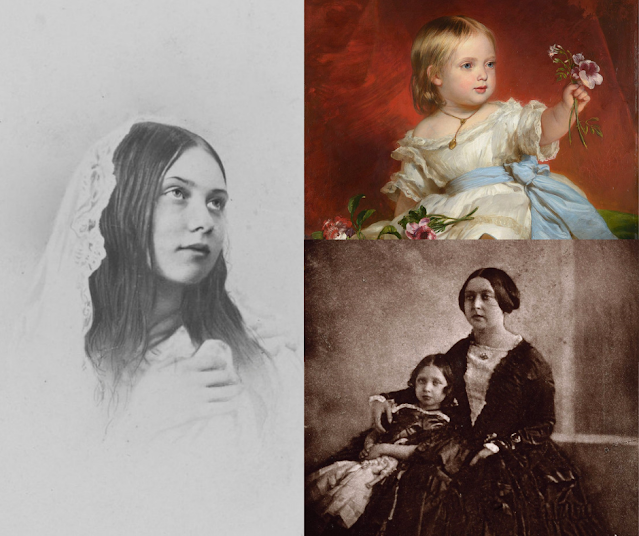Shortly before the early hours of November 21, 1840, Queen Victoria woke up feeling in utter discomfort. Heavily pregnant with her first child, she was expecting to give birth, but within another fortnight. She recorded: “Just before the early hours of the morning of the 21st I felt again very uncomfortable & with difficulty aroused Albert . . . Tried to get to sleep again, but by 4, I got very bad & both the Doctors arrived. My beloved Albert was so dear and kind. . . Locock said the Baby was on the way & everything was all right. We both expressed joy that the event was at hand & I did not feel at all nervous.”
 |
| Vicky with her father Prince Albert and his greyhound Eos. Portrait by John Lucas, 1841. |
 |
| Queen Victoria and the Princess Royal in 1842. |
 |
| A Winterhalter portrait of Victoria, Princess Royal, c1842. |
.jpg) |
| Victoria, Princess Royal, 1855. |
Queen Victoria had earlier expressed her disgust of having a number of persons present to attend and witness a royal birth. Hence, when the princess was born, there was only Dr. Locock, Mrs. Lilly the nurse-midwide, and Prince Albert in the room where she gave birth. Waiting in the antechamber were Sir James Clark, The Queen’s physician and two assisting doctors, just in case Dr. Locock needed some help. In another room were the Prime Minister Lord Melbourne, the Foreign Minister and the Archbishop of Canterbury, waiting for the wail of a newborn.
The teaching of her father, Prince Albert, produced great effect upon her mind, for she had from her earliest years been his constant companion. He delighted in her quick intelligence and lively mind. She often accompanied him in his walks, when he taught her how to know every herb and plant by its English, German, and Latin name. Precocious and intelligent, Victoria began to learn French when she was 18 months old. Under the tutelage of Mlle. Aimee Charrier and, later, Sarah Ann Hildyard, the princess mastered French and German. She began to study German at four and learned Greek and Latin eventually. At six years old, she was taught arithmetic, geography and history, and her father tutored her in politics and philosophy. She also studied science and literature and later devoured Gibbon’s Decline and Fall of the Roman Empire, George Eliot, Dickens, the Bronte sisters and Shakespeare. As she grew older, she had decidedly changed into what Lady Lyttelton called a “fine character.”
Prince Albert, writing to Baron Stockmar, that Pussy had become "quite a personage. She speaks English and French with great fluency and choice of phrase." Her "quick, clever, self-willed and high-spirited character" has allowed her to easily outdistance her siblings. As Frederick Ponsonby later wrote, “ Acute observers dubbed her overstimulated and even precocious, but the rapidity of thought was not a passing phase—it remained with her to the end." Her school days, interrupted by three hours of recreation, began at 8:20 and finished at 18:00. She was a total opposite to her brother, whose educational program was even more severe, Victoria was an excellent student who was always hungry for knowledge despite her obstinate character.
You can learn more about the life of Victoria, Princess Royal in the book Vicky, Dear: The Life of Victoria, Princess Royal, and Empress Frederick (Royal Splendour, 2023). This insightful short biography unveils the complexities of Victoria's relationships, her unwavering devotion to her family, and her enduring impact on European history. The author paints a captivating portrait of a woman who defied convention, shattered barriers, and left an indelible mark on the world. From the opulent halls of royalty to the corridors of power, embark on an epic journey as you discover the captivating story of Victoria, Princess Royal and Empress Frederick, and experience a remarkable era through her eyes. Available in Amazon and Kindle. Click here to order your copy.
More stories about the Victoria, Princess Royal and Empress Frederick here:
- The birth and childhood of Victoria, the Empress Frederick
- Victoria Princess Royal with the Greyhound Eos
- Vicky gives birth: "One of the worst recorded in obstetrical history"
- The wedding of Victoria, Princess Royal, and the future Emperor Frederick III
- Vicky travels to Berlin
- Victoria and Frederick: A royal love story



.png)





0 Comments